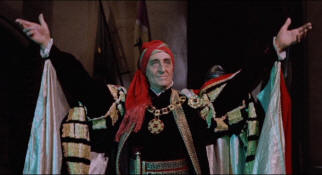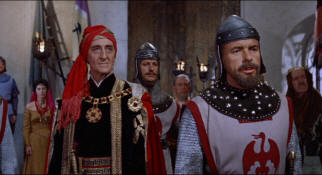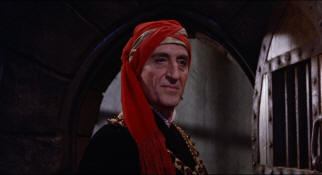|
 This film, also known as St. George and the Seven Curses, concerns a gallant knight's crusade to rescue his beloved princess,
with magic working for and against him. Basil Rathbone plays Lodac, an evil sorcerer in an unnamed
land ruled by a king. Lodac has
kidnapped 18-year-old Princess Helene and threatens to feed her to his
two-headed dragon. Lodac wants the king to suffer because the king's
father executed Lodac's sister for witchcraft when she was 18 years old. This film, also known as St. George and the Seven Curses, concerns a gallant knight's crusade to rescue his beloved princess,
with magic working for and against him. Basil Rathbone plays Lodac, an evil sorcerer in an unnamed
land ruled by a king. Lodac has
kidnapped 18-year-old Princess Helene and threatens to feed her to his
two-headed dragon. Lodac wants the king to suffer because the king's
father executed Lodac's sister for witchcraft when she was 18 years old.
Sir Branton, a knight who hopes to marry the princess, declares that he will save her. But someone else is determined to save the princess—George, an orphan
of royal blood, who has been raised by the sorceress Sybil. She tells him
that his real parents were royalty. He is Sir George, a
knight by virtue of 400 years of royal lineage. She doesn't want him
trying to rescue the princess because he is only 20 years old. But she
shows him the magical items that will be his when he turns 21: "Ascalon" (a magic sword), magic armor that no sword can
pierce, and Bayhar, the fastest horse in the land.
George tricks Sybil and takes the magical items. He also revives six knights who had been turned into stone.
These
knights represent different countries: Sir
Dennis of France, Sir Patrick of Ireland, Sir Anthony of Italy, Sir Ulrich
of Germany, Sir Pedro of Spain, Sir James of Scotland. With his red and white shield
George clearly represents St. George of England.
But there are many perils they must face before they reach Lodac's
castle. Lodac has placed seven deadly curses in their path. As
if the curses weren't challenging enough, George has to deal with Sir Branton's
treachery. Branton is working with Lodac in order to win the Princess. He
is therefore trying to prevent George from succeeding.
The curses include:
Although one of George's knights dies at each of the deadly curses,
George eventually reaches Lodac's castle.
In the fight that ensues, George loses his sword to Lodac.
The sorcerer double-crosses Branton, who ends up with his head mounted on the
wall. George is imprisoned in the castle.

Lodac and one of the King's Guard |

Lodac the Evil Sorcerer |
Transforming herself into a bird, Sorceress Sybil
flies to the castle to rescue George and Helene.
Some
miniature people, prisoners of Lodac, are accidentally freed. They
combine their strength to carry the magic sword Ascalon to George's cell and
cut his bonds. George dons his armor, mounts Bayard and heads off to fight
the dragon and save Helene. Courageously George charges the dragon. It is a seemingly
uneven battle, but eventually George kills the Dragon.
Sybil tricks Lodac into letting her grab his Magic Ring while
he rages at the defeat of his dragon. Lodac now prepares to unleash the
final curse, number 7. But we never find out what curse number 7 is
because Lodac has lost his Magic Ring and his power to harm George. Armed
with Lodac's Magic Ring, Sybil turns herself into a black panther and
attacks Lodac, who dies a bloody death. At the demise of Lodac his
magic spells are dissipated and the six brave knights are restored to life.
|
The Magic Sword
Dragons, ogres, demons and wildly imaginative special
effects — in vivid color — to thrill
youngsters and adventuresome elders. Lively attraction for vacation-time.
Pure escapist entertainment,
this thrill-filled fantasy overflowing with imaginative Eastman Color
special effects shapes up as a solid attraction for the youngsters and the
young-in-heart. Supported with a colorful promotion campaign by United
Artists, this figures to be an above-average grosser whenever the youth
trade is out of school, at holidaytime or during Summer vacation.
Excitement, a story book romance, and a nice sprinkling of humor have been
deftly blended into a fast-moving show by producer-director Bert I.
Gordon. And the moppets will go wild over the special effects — a magic
sword, a 25-foot ogre, boiling craters, green fire demons, a vampire
witch, midgets locked in a cage, hags, a gloomy castle and a two-headed
flame-breathing dragon. Basil Rathbone hams it up grandly as an evil
sorcerer, while Estelle Winwood gives her comic all as a whacky witch.
Handsome Gary Lockwood is Miss Winwood's foster-son, in love with the
beautiful princess, and Anne Helm portrays the latter in true fairy tale
fashion Bernard Schoenfeld's screenplay finds Rathbone kidnapping Miss
Helm. Lockwood, protected by his magic sword, seven brave knights and
wicked Liam Sullivan set out to rescue her. Rathbone's black magic
eliminates the knights, and Miss Winwood accidentally takes away the power
of the magic sword. Rathbone captures Lockwood and forces him to watch
Miss Helm being prepared for the dragon. Lockwood escapes, finds his magic
powers restored, and slays the dragon. Rathbone kills Sullivan, and Miss
Winwood, now changed into a black panther, takes care of Rathbone. The
seven knights return to life, and Lockwood and Miss Helm live happily ever
after.
—Film Bulletin, April 16, 1962 |
The silliness and over-the-top acting in The Magic Sword would normally
have triggered complaints from the critics, but, as this film was intended
as entertainment for children, the critics didn't complain.
"The veterans in the cast delivered the best performances. Rathbone was
an effective heavy."
—Michael B. Druxman, Basil Rathbone: His Life and His Films (South Brunswick
and New York: A.S. Barnes, 1975)
"Basil Rathbone is well-cast as an awesome and menacing sorcerer."
—Hollywood Reporter, April 1962

Lodac and the hag |

Lodac forces the princess to watch a horror. |
Producer/Director Bert I. Gordon started working on the film, which he
called St. George and the Seven Curses, in January 1961. The March 6, 1961 issue of Boxoffice Barometer reported that
filming on St. George and the Seven Curses had been completed, but
United Artists didn't release it to theatres in the USA until March 1962. The title was
changed to The Magic Sword shortly before the film was released in
the USA. In the United Kingdom, however, the film's release was delayed
until March 1964, and then it was released under the original title.
Looking at The Magic Sword today, the special effects seem
primitive. But in 1962 they were considered good. Bert Gordon was
recognized as one of the top special effects experts in the industry. He
budgeted $100,000 for special effects alone.
It
was reported in Fantastic Monsters of the Films, that the model of the
dragon took nearly four months to construct,
was some twenty feet in length and was “operated manually by six men on the
inside.” On
screen, the dragon’s scale appears as a more monstrous 150 feet in length…
and that’s not to mention its fire breathing capabilities.
|
Movie Magic for The Magic Sword
There's slick color photography and scores of unusual
special effects in this terror-fantasy film that holds much for students
of cinematography and moviegoers alike.
"The Magic Sword," an exciting terror-fantasy photographed
in Eastman Color for United Artists by Paul Vogel, A.S.C., is a tour de
force of spectacular illusions achieved through a highly complex
combination of special effects techniques. ...
"The Magic Sword" is a colorful tale of derring-do based
on the legend of St. George and the Dragon. By combining animation,
traveling mattes, split-screen and superimposition techniques, Gordon has
ingeniously created battles, first with a 25-foot ogre and later with a
giant two-headed fire-breathing dragon which, on the screen, appears to be
forty feet long. There are also haunted forests, magic mirrors,
demon-possessed caverns, fluorescent ghosts and a variegated collection of
off-beat characters including evil sorcerers, assorted hags, "little
people," giants, pinheads, dwarfs, specters and birdmen.
 The "star" of the show, at least from the special effects
standpoint, is of course, the dragon. The model of this double-featured
monster was actually only eight feet long. Activated by wires and
mechanical controls, it was rigged with compressed air jets to make its
twin tongues lash out angrily. It was also equipped with gas ducts
enabling it to spew sheets of flame from all four nostrils. a moment of
anxiety developed when the dragon backfired—that
is, he breathed in when he should have breathed out, thereby setting his
costly innards on fire. Quick thinking by a standby fireman, who rushed in
with a cooling drink, relieved the dragon's "heartburn." The "star" of the show, at least from the special effects
standpoint, is of course, the dragon. The model of this double-featured
monster was actually only eight feet long. Activated by wires and
mechanical controls, it was rigged with compressed air jets to make its
twin tongues lash out angrily. It was also equipped with gas ducts
enabling it to spew sheets of flame from all four nostrils. a moment of
anxiety developed when the dragon backfired—that
is, he breathed in when he should have breathed out, thereby setting his
costly innards on fire. Quick thinking by a standby fireman, who rushed in
with a cooling drink, relieved the dragon's "heartburn."
In creating the battle with
the dragon, the live action involving George and the captive princess, was
filmed first, and the miniature dragon photographed and printed-in to the
scene later. One of the main problems was to cue the live action so that,
at moments when the dragon would be charging and spraying flame, the live
actors would back away and simultaneously be illuminated by the glow of
the flames. Intricate timing charts were prepared so that the action of
the dragon could later be cued to the exact frame to match that of the
live players.
Another important
consideration in the dragon battle sequence was that of visual continuity.
Great care had to be taken to insure that the perspective of scenes
showing the dragon would match those of the live-action scenes, Vogel
explains, since the camera constantly cut from high to low angles. It was
also important that the dragon remain the same size in relation to its
human adversary throughout the sequence. When the dragon was shown alone,
cinematographer Vogel was careful to select camera angles that would
faithfully duplicate the point-of-view of the man fighting the beast. ...
An interesting effect
involved bringing to life six stone images of knights who had presumably
been ossified by an evil sorcerer centuries before. The shot of the
"stone" knights was achieved by taking a frame of the live scene showing
the knights standing in a row and, through a series of photographic
processes, producing an extremely high-contrast black and white print of
the scene having almost the quality of a line drawing. Shading was then
carefully added to create the illusion of three-dimensional stone figures.
Then, by means of a dissolve precisely matched to the original scene, the
knights appeared to take on life, color and movement.
The effect which presented
the biggest challenge to Gordon and cinematographer Vogel, and which
required the greatest amount of time to create, had to do with the
appearance of disembodied demon heads floating in space in a haunted
cavern. Gordon had speculated that the desired weird effect could be
produced by painting plaster models of shrunken heads and death masks with
fluorescent paint and then illuminating them with ultra-violet or
so-called "black" light. Here the problem was to get the paint to glow
brightly enough to register on film. Since a "floating" effect was
required, it was impossible to undercrank the scene at less than 20 frames
per second—and even with an exposure of f/2 it was necessary for Vogel to
pour a tremendous amount of the barely visible "black" light into the
scene in order to get the fluorescence to show up on film.
After the heads had finally
been successfully photographed in a frosty green glow, the problem
remained of superimposing them, properly balanced, over the background
scene. This was done in the optical printer, and a great deal of
experimentation with printer lights and filters was necessary to get the
heads to burn through with just the right degree of ghostly translucence.
The resultant sequence on the screen, especially when accompanied by weird
sound effects, creates a spell of flesh-crawling horror.
The most costly sequence to
shoot took place in a fog-shrouded forest. Built on the sound stage at the
Samuel Goldwyn Studios, the set was a tangle of peculiarly stark,
tortured-looking trees unlike any flora on earth. The "trees" were
actually upended cypress stumps with "branches" formed by the roots
writhing into the air and seeming to clutch at the characters as they rode
by on horseback. ...
Whereas many film-makers
specializing in fantasy limit themselves to photographing miniatures
straight on, Gordon treats miniatures in the same way that he would live
players—using a variety of angles, over-shoulder shots and closeups. He
feels that this creates added realism, ties the effect in more closely to
other visual elements, and gives the audience less opportunity to pick the
effect apart.
"In a straight type of
picture you can get away with almost anything," he points out. "But in an
out-and-out fantasy your audience is looking for things to jump on,
defying you to fool them. Because they have this chip-on-the-shoulder
attitude you have to make sure that every effect you use is as good as you
can possibly get it. It is for this reason also that I engage the very
best technicians I can get—for example, A.S.C. cameramen like Paul Vogel,
Ernest Haller and Joseph Biroc. I learned long ago that there's no
substitute for talent."
—Darrin Scot, American Cinematographer, March 1962 |
"Entertaining, often (unintentionally) hilarious adventure. Young knight Lockwood sets out to rescue beautiful princess Helene, who's been kidnapped by evil sorcerer Rathbone. In their better moments, Lockwood and Helm seem like refugees from a Beach Party movie; Rathbone and Winwood offer knowingly hammy performances." —Leonard
Maltin, Leonard Maltin's Classic Movie Guide, 2015
"With his usual skill, Basil Rathbone
breathes life into the role of the evil sorcerer in this juvenile fairy
tale. Filmed in color, producer Bert I. Gordon's recent production
contains more values than usual."
—"The Basil Rathbone Story," Chiller, 2001

Lodac yells to the dragon to destroy George. |

Lodac sees Sybil as a panther about to attack him. |
Liam Sullivan, the actor who played Sir Branton, shared this memory of
Basil Rathbone during the filming of The Magic Sword: "Basil Rathbone was a funny man. A story teller. Every time the camera
stopped Basil had another story to tell. He was just wonderful."
—quoted in Tom and Jim Goldrup’s book The
Encyclopedia of Feature Players of Hollywood, vol. 3 (Bear Manor, 2012)
According to a press release for The Magic Sword, Basil Rathbone interrupted his
"Evening with Basil Rathbone" tour to portray Lodac because he
considered the warlock "the most villainous, treacherous, wretchedest evil-doer it has ever been my very good fortune to play."
The Magic Sword Here is a tongue-in-cheek
fairy tale which rises to heights of satirical splendor at times and
sinks to ordinary contrived narrative at others. If designed for
children, it is somewhat macabre; if for adults, it could get
sniggers. but all-in-all, it's a well-mounted, ingeniously created
piece of merchandise that has excellent special effects. It is a
fantasy which combines witchcraft, sorcery, romance and knighthood,
all woven into a tale of adventure, a crusade to rescue a beautiful
imprisoned princess from the clutches of a nefarious sorcerer. Basil
Rathbone is the sole name of consequence, although Estelle Winwood
is known because of past stage roles. Anne Helm as the princess and
Gary Lockwood as her rescuing lover make a good team, while Liam
Sullivan is quite adequate as a traitorous knight. Highlights of the
picture are the effective special visual effects, created by Bert I.
Gordon, who also wrote the story, produced and directed it. some of
such effects are people reduced to the size of little dolls, a
fire-breathing dragon, mirrors that have television effects and
numerous other gimmicks that keep the story going at a fast pace.
The Eastman Color is good.
—Box Office, April 16,
1962 |
"The kidnapper of the Princess is the dastardly Lodac, played by the
wonderful Basil Rathbone, who brings a touch of class even to cheaply
produced kiddie-fodder like this." Richard Cross,
20/20 Movie Reviews
In Season 4 of Mystery Science Theater 3000 (episode 11), the
cast poked fun at The Magic Sword, including promoting a fake product
called Basil Rathbone's Dog Biscuits. The "commercial" went like this:
"You know, you get out of your dog what you put into it. And I
only put in the best: Basil Rathbones. . . . We all need affection,
occasional grooming and lots of snacks. Dogs just go nuts for the
taste of Basil Rathbones. One Rathbone a day will clean Doggie's teeth
and freshen doggie's breath. . . . Hey, these are too good to be good
for you.
Basil Rathbones! And Pesto-flavored Basil Rathbones for the
pretentious dog."
Gary Lockwood is known for his role as Frank Poole in 2001: A
Space Odyssey.
.
The Magic Sword can be streamed and downloaded for free from Archive.org!
https://archive.org/details/TheMagicSwordWidescreenQualityUpgrade
embed code:
See Page Two for pictures of posters,
lobby cards and promo photos.
.
|
Cast |
|
| Basil Rathbone
... |
Lodac |
| Estelle Winwood
... |
Sybil |
|
Gary Lockwood ... |
Sir George |
|
Anne Helm
... |
Princess Helene |
|
Merritt Stone
... |
King |
|
Liam Sullivan ... |
Sir Branton |
|
John Mauldin
... |
Sir Patrick |
|
Jacques Gallo
... |
Sir Dennis |
|
Leroy Johnson
... |
Sir Ulrich |
|
David Cross
... |
Sir Pedro |
|
Angus Duncan
... |
Sir James |
|
Taldo Kenyon
... |
Sir Anthony |
|
Danielle De Metz
... |
Mignonette |
|
Marlene Callahan
... |
Princess Grace |
|
Nick Bon Tempi ... |
Siamese Twin |
|
Paul Bon Tempi ... |
Siamese Twin |
|
Ann Graves ... |
Princess Laura |
|
Lorrie Richards ... |
Anne |
|
Jack Kosslyn ... |
The Ogre |
| Maila Nurmi (Vampira)
... |
The Hag |
|
Ted Finn ... |
First Dwarf |
| Angelo Rossitto
... |
Second Dwarf |
|
Richard Kiel ... |
Pinhead |
| |
|
| |
|
|
|
|
Credits |
|
|
Producer ... |
Bert I. Gordon |
|
Distributor ... |
United Artists
|
|
Director ... |
Bert I. Gordon |
|
Production Manager ... |
Herbert E. Mendelson |
|
Asst. Director ... |
Herbert E. Mendelson |
|
Story ... |
Bert I. Gordon |
|
Screenplay ...
|
Bernard Schoenfeld |
|
Cinematographer ... |
Paul Vogel |
| Original Music
... |
Richard Markowitz |
|
Production Designer ... |
Franz Bachelin |
|
Set Decorator ... |
George R. Nelson |
|
Hair Stylist ... |
Lynn Burke |
|
Makeup Artist ... |
Daniel C. Striepeke |
|
Property Master ... |
Arthur Friedrich |
|
Sound ... |
James Brock |
|
Sound Effects Editor ... |
Martin Greco |
|
Sound Re-recordist ... |
Roger Heman |
|
Special Effects ... |
Milt Rice |
|
Special Visual Effects ... |
Bert I. Gordon, Flora Gordon |
|
Stunts ... |
Leroy Johnson |
|
Wardrobe (women) ... |
Esther Krebs |
|
Wardrobe (men) ... |
Oscar Rodriguez |
|
Supervising Editor ... |
Harry Gerstad |
|
Orchestrator ... |
Willaird Jones |
|
Music Editor ... |
William Sawyer |
|
Script Supervisor ... |
Robert Gary |
|
Gaffer ... |
Lloyd Hill |
|
Production Assistant ... |
Shirley Vaughan |
|
Dragon "Trainer" (puppet operator) ... |
Ross Wheat |
| |
|
|
|
Images on this page and page two are from the film
The Magic Sword.
|
The Magic Sword is available
|
.
|




















